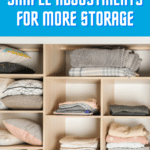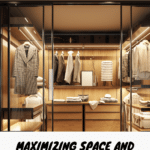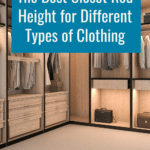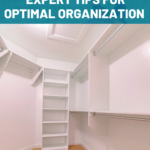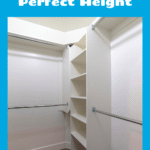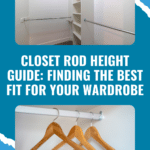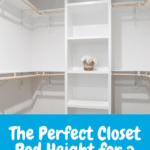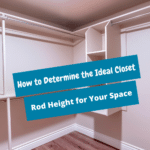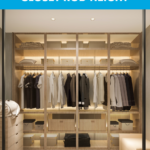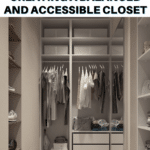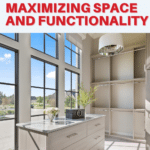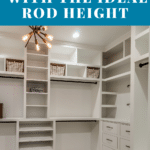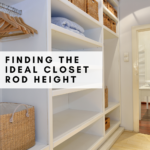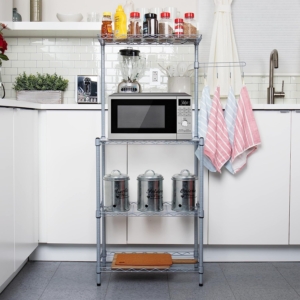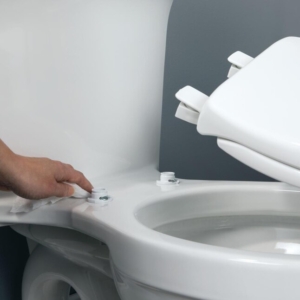Maximizing Space and Efficiency: Finding the Perfect Closet Rod Height

A well-organized closet can make a world of difference in our daily lives. It saves us time, reduces stress, and helps us maintain a tidy living space. While we often focus on organizing our clothes, shoes, and accessories, we sometimes overlook the closet rod height. The placement of your closet rod can significantly impact storage capacity and accessibility. In this blog post, we will explore the key considerations for determining the ideal closet rod height and practical tips to maximize space and efficiency.
Understanding Closet Rod Height
A closet rod, a clothing rod, or a hanger bar is a horizontal bar typically installed within a closet space. Its primary purpose is to hang clothing items, allowing easy access and preventing wrinkles and creases.
Factors to Consider When Determining the Ideal Height
To find the optimal closet rod height, several factors should be taken into account:
1. Clothing Types and Lengths
Consider the types of clothing you typically hang in your closet. Shirts, blouses, skirts, and other short garments require less vertical space, while dresses, pants, and long coats need additional clearance. By assessing your clothing inventory, you can determine the appropriate height for your closet rod.
2. User Height and Accessibility Needs
Your own height and physical accessibility requirements should influence the placement of the closet rod. If you’re taller, you may want to raise the rod to avoid garments dragging on the floor. Conversely, shorter individuals or those with mobility challenges may prefer a lower rod height for ease of use.
3. Available Space and Storage Requirements
The dimensions of your closet and your storage needs play a crucial role in determining rod height. Consider the vertical space available and the number of garments you need to hang. Balancing storage capacity with easy access is essential to achieve an efficient closet layout.
Standard Closet Rod Height
The industry offers some general guidelines for closet rod height:
– Single Rod: A standard height for a single closet rod is typically around 66 to 70 inches from the floor. This height allows for a mix of short and medium-length garments.
– Double Rod: You can incorporate a double rod system to maximize space. The higher rod is typically positioned around 80 to 84 inches, while the lower rod is placed around 40 to 44 inches from the floor. This arrangement allows for more hanging space without sacrificing accessibility.
Pros and Cons of Adhering to Standard Heights
Adhering to standard closet rod heights can have its advantages and disadvantages:
Pros:
– Widely accepted and used by manufacturers and professional organizers
– Provides a good starting point for those unsure of where to place their rods
– Works well for most people with average clothing lengths
Cons:
– May not accommodate longer garments or individuals with specific needs
– Can result in wasted vertical space if you have an atypical clothing collection
– Does not account for individual preferences and accessibility requirements
While the standard heights serve as a helpful reference, it’s essential to customize them to suit your specific needs. Here are a few considerations for adjusting the rod height:
– Clothing Length: If you predominantly wear longer garments, such as maxi dresses or trench coats, consider raising the rod to provide ample clearance.
– Accessibility: If you have mobility challenges or children who need access to their clothing, lowering the rod height can make it easier for them to reach their items independently.
– Vertical Space: If you have high ceilings, use the extra room by installing a taller rod or incorporating a double rod system to maximize storage.
Customizing Closet Rod Height
A. Assessing Clothing Types and Lengths for Optimal Storage
To make the most of your closet space, it’s crucial to evaluate the types and lengths of clothing you own. Here’s a breakdown of how to optimize storage for different garment categories:
1. Short Garments (Shirts, Blouses, Skirts): These items typically require less vertical space. Placing the rod lower will ensure efficient utilization of closet space.
2. Medium-Length Garments (Dresses, Pants): These garments may benefit from a standard or slightly higher rod height. Consider leaving some clearance to prevent longer items from touching the floor.
3. Long Garments (Coats, Gowns): To accommodate longer items, raise the rod height or dedicate a separate section of the closet with an extended rod for such garments.
B. Considering User Height and Accessibility Requirements
The height of the primary user(s) is a vital consideration when determining closet rod height. Tailor the placement to ensure ease of access and prevent strain or inconvenience.
– Taller Individuals: Raise the rod to avoid garments dragging on the floor and to provide a visually pleasing display.
– Shorter Individuals: Lowering the rod height enables comfortable reach and accessibility.
– Accessibility Needs: If you or someone in your household has mobility challenges, ensure the rod is at a suitable height to facilitate independent use.
C. Adapting Closet Rod Heights for Specific Items
While the primary closet rod holds most of the hanging garments, there are other storage needs to consider:
– Shoe Racks: Dedicate a lower section of your closet with a lower rod or shoe rack to store shoes, maximizing vertical space and keeping them organized.
– Folded Clothes: Allocate shelves or drawers within the closet for folded items, such as sweaters or t-shirts. Leave enough vertical clearance above to accommodate the folded height.
Space Optimization Techniques
A. Utilizing Double Rods for Increased Storage Capacity
If space allows, consider installing a double rod system. This arrangement effectively doubles the hanging space while maintaining accessibility. Longer garments can be hung on the higher rod, while shorter items or accessories can go on the lower rod.
B. Incorporating Adjustable Rods and Shelving Systems
Adjustable rods and shelving systems offer flexibility to adapt to changing storage needs. These systems enable you to modify the height of the rods and shelves, ensuring optimal space utilization for different clothing and accessory types.
C. Using Specialized Accessories to Maximize Space
Take advantage of various accessories designed to maximize storage within your closet:
– Hooks: Install hooks on the closet walls to hang belts, ties, scarves, or other accessories, freeing up valuable rod space.
– Hangers: Utilize space-saving hangers, such as cascading hangers or slim velvet hangers, to optimize hanging capacity.
– Bins and Baskets: Use storage bins or baskets to corral smaller items like socks, lingerie, or accessories, keeping them organized and easily accessible.
D. Tips for Organizing Accessories
To keep your accessories tidy and easily accessible, consider the following tips:
– Belts and Ties: Hang belts and ties on dedicated hooks or hangers, or use belt and tie racks for efficient storage.
– Scarves: Install a scarf hanger or use scarf rings to keep your scarves neatly displayed and easily accessible.
V. Installation and Adjustments
If you’re installing a new closet rod, here are some steps:
1. Measure and mark the desired height on both sides of the closet walls.
2. Use a level to ensure the marks are even.
3. Install appropriate hardware, such as closet rod brackets, according to the manufacturer’s instructions.
4. Insert the rod into the brackets and secure it in place.
Tips for Adjusting Rod Height in an Existing Closet
If you need to adjust the rod height in an existing closet, consider these tips:
– Determine the desired height based on your assessments and preferences.
– Remove the current rod and brackets.
– Fill any existing holes with putty or spackle.
– Follow the manufacturer’s instructions to install new brackets at the desired height.
– Insert the rod into the brackets and ensure it is secure.
DIY Solutions for Modifying Rod Height
If you’re looking for a temporary or flexible solution, try these DIY methods:
– Tension Rods: Use tension rods to create additional hanging space at a desired height. This is a convenient solution that doesn’t require permanent installation.
– Hanging Chains: Attach chains from the existing rod to create an additional hanging level below. Adjust the length of the chains to achieve the desired height.
Additional Considerations
A. Impact of Ceiling Height on Closet Rod Placement
The height of your ceilings can influence the placement of your closet rod. If you have high ceilings, take advantage of the vertical space by raising the rod height and incorporating double rods or shelves.
B. Considerations for Shared or Multifunctional Closets
Shared or multifunctional closets require additional planning to accommodate the needs of different users or purposes. Consider implementing separate rod heights or designated sections to optimize storage for each individual or function.
C. Accessibility Considerations for Individuals with Mobility Challenges
Accessibility is crucial for individuals with mobility challenges. Ensure that the closet rod height allows for easy reach and use, or consider installing additional rods at various sizes for increased accessibility.
Summary
A well-organized closet is within reach, and determining the perfect closet rod height is crucial to achieving that goal. By assessing your clothing types, user height, and storage requirements, you can customize the rod height to maximize space and accessibility. Incorporating space optimization techniques, adjusting rod heights, and utilizing specialized accessories will further enhance the efficiency of your closet. Remember, there are no hard and fast rules regarding closet rod height—personalization is needed. With some planning and attention to detail, you can create a functional and organized closet that meets your unique needs. So, get started today and make the most of your storage space!


